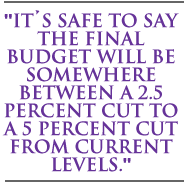 THE UNIVERSITY OF WASHINGTON ALUMNI MAGAZINE
THE UNIVERSITY OF WASHINGTON ALUMNI MAGAZINE
 THE UNIVERSITY OF WASHINGTON ALUMNI MAGAZINE
THE UNIVERSITY OF WASHINGTON ALUMNI MAGAZINE
|
BriefingsCuts a Certainty-Amount Still Waits for Olympia to DecideThe UW can expect a cut in the amount of money coming from the state to support its teaching mission, but as Columns went to press in mid-May, the exact amount was still undecided. Facing a $2.6 billion deficit, the state Legislature could not reach a budget compromise before the end of its regular session April 27. Gov. Gary Locke called it back into special session on May 12. Before the regular session ended, the House of Representatives had passed a 2003-05 budget that included about $648 million for the UW, while the Senate version was about $608 million.  "It's safe to say the final budget will be somewhere between those two numbers, which range from a 2.5 percent cut to a 5 percent cut from current levels," says UW Director of Government Relations Dick Thompson, '68. He says these cuts could mean fewer classes and larger class sizes for the teaching program. In preparing for a five percent budget cut, the College of Arts and Sciences predicted it would risk losing up to 40 faculty positions, 34 teaching assistantships and 31 other positions. The effect would be to drop about 164 courses from the arts and science curriculum. Both budget plans allow the UW to raise tuition, which could soften the effects of these reductions. The House allows the UW to raise resident undergraduate tuition 6 percent in each year of the biennium; the Senate has a 9 percent hike. Thompson cautions that even if a 9 percent raise is authorized, the additional funds would not cover all the coming cuts. Resident undergraduate tuition and fees are currently $4,636. A 9 percent increase each year would put the total at $5,051 this fall and $5,506 in fall 2004. One bright spot in both budget plans is money set aside for retaining and recruiting top professors. Both plans devote $10 million for higher education institutions, with the UW getting $4.6 million. "While the dollars are important, so is the message the Legislature is sending," says Thompson. "They appreciate the difficulty we have recruiting and retaining top faculty."  Except for high demand courses such as nursing and computer sciences, neither budget allows for enrollment increases at any four-year public institution. Since state high school numbers are still climbing, this will mean added pressure to get into the UW. "Parents have to understand this is related to how much the state provides and how much the University can do. You can't expand enrollment while cutting the funding. It just won't work. It thins the soup too much," Thompson explains. The state capital budget is also in flux, but one UW project is on both the House and Senate list-renovation of Johnson Hall (see "Inside Out," March 2003). "The House fully funds the $53 million renovation while the Senate expects the UW to cover about $16 million with local revenue, so the House version is preferable," says Thompson. Another important capital item is a plan by former Governors Booth Gardner and Dan Evans to fund higher education construction costs by raising the state debt limit. While the Senate passed a 10-year version of their plan, the House incorporated some of their ideas into a six-year plan in its regular capital budget. "It may or may not emerge as a separate plan at the end of the session," says Thompson.
|